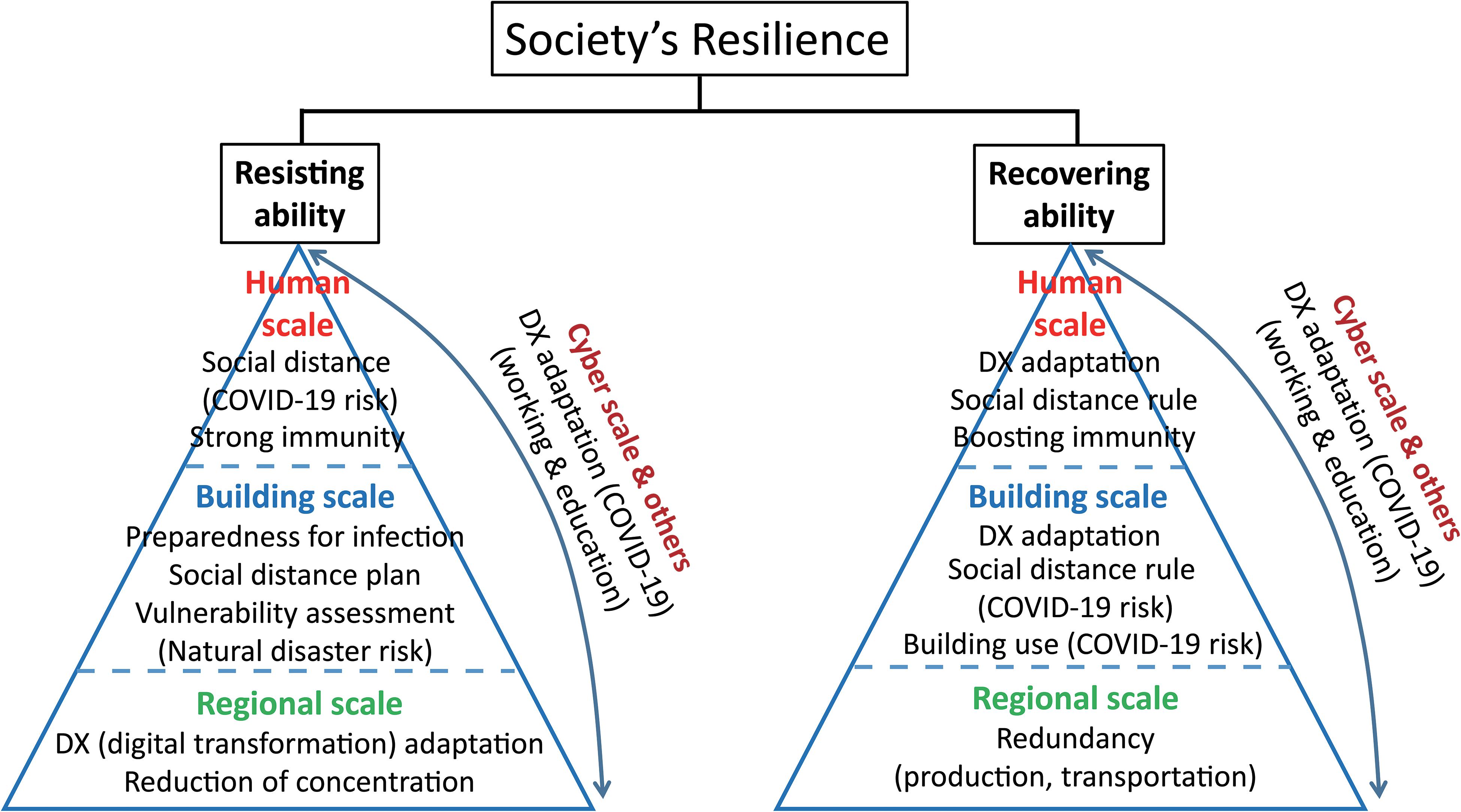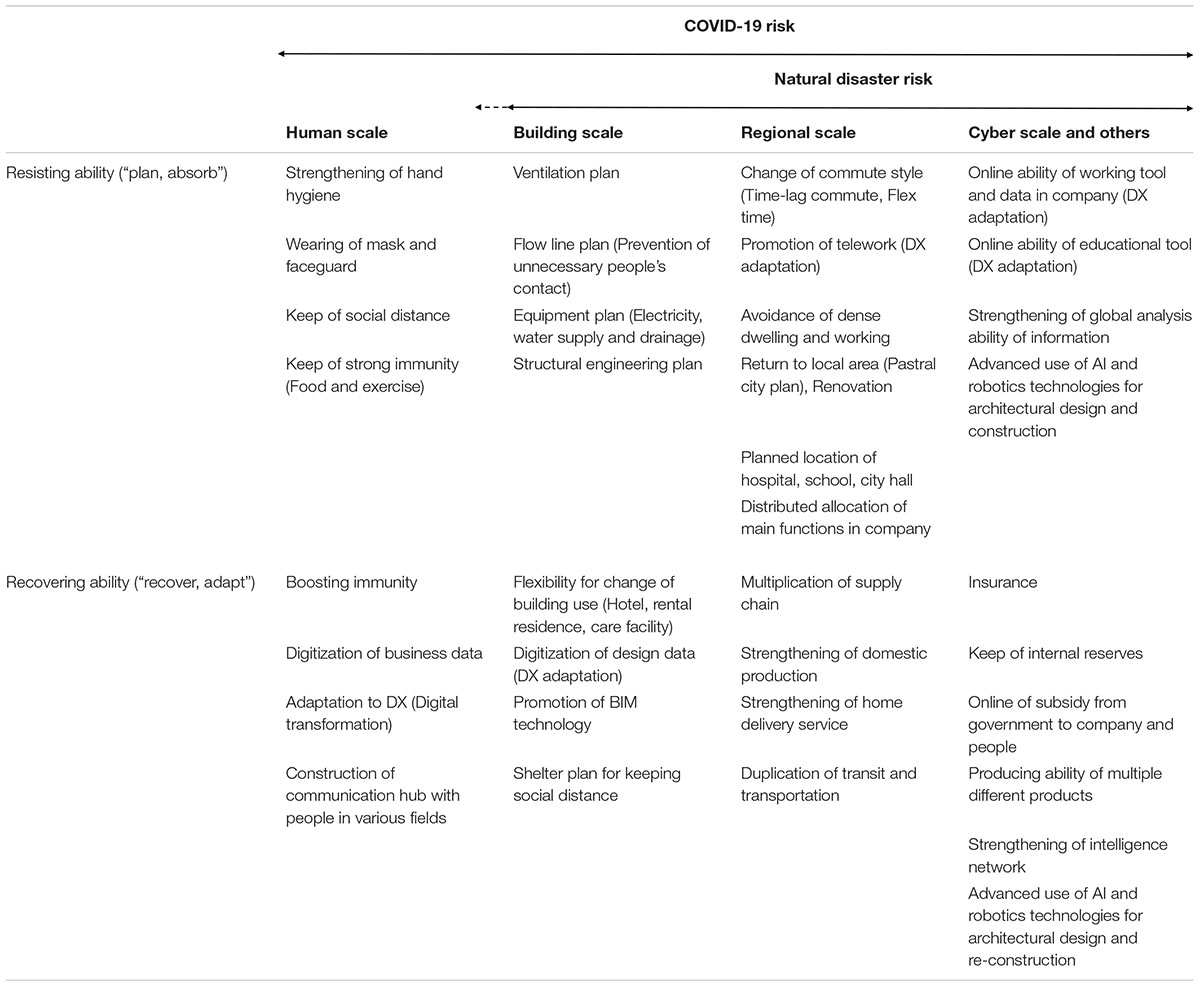- Department of Architecture and Architectural Engineering, Kyoto University, Kyoto, Japan
The spread of COVID-19 all over the world since the beginning of the year 2020 requires a re-thinking of the meaning of the term “resilience” in the field of architecture and architectural engineering. Resilience from the viewpoint of architecture and architectural engineering has been investigated primarily in terms of conventional natural disaster risks (see, for example, Bruneau et al., 2003; Cimellaro et al., 2010; Architectural Institute of Japan [AIJ], 2020a). However, COVID-19 reminds us of the need to investigate resilience also in terms of infection risks. The places where people become infected are principally within buildings and transportation systems. Especially in buildings, three factors considered to be main risks for infection (closed spaces without ventilation, dense gatherings, close connection) often occur. For this reason, the role of architecture and architectural engineering is essential from the viewpoint of reducing the risk of infection, using versatile knowledge and technologies from the fields of architectural and regional planning. Following the appearance of COVID-19, architectural designers and engineers have an important mandate to think about the role of buildings and their related fields.
Since the beginning of 2020, the COVID-19 virus has spread all over the world, requiring us to re-think the meaning of “resilience” in the fields of architecture and architectural engineering. In architecture and architectural engineering, resilience has traditionally been investigated primarily in terms of conventional natural disaster risks (see, for example, Bruneau et al., 2003; Cimellaro et al., 2010; Architectural Institute of Japan [AIJ], 2020a). COVID-19 reminds us of the need to also investigate resilience in terms of infection, due to the fact that the places where people become infected are principally buildings and transportation systems. At present, the three main factors that increase risk of infection (closed spaces without ventilation, spaces that encourage dense gatherings, and environments that foster close physical connections) often occur in buildings. Versatile knowledge and technologies from the fields of architectural and regional planning could play an essential role in reducing these risks. Following the appearance of COVID-19, architectural designers and engineers have an important mandate to re-think the role of buildings and other related fields.
By focusing on aspects of architecture, it is possible to consider a society of resilience that encompasses health-related risks like COVID-19 alongside conventional natural disaster risk. Aspects of “resisting ability” and “recovering ability” offer a way of classifying factors at multiple scales that might enhance resilience toward both COVID-19 risk and conventional natural disaster risk. These abilities represent the two main constitutive factors of resilience (see Figure 1 and Table 1). Resisting ability describes the process of being able to “plan and absorb” (Linkov and Trump, 2019), and recovering ability corresponds to the process of being able to “recover and adapt” (Linkov and Trump, 2019). These abilities also provide new concepts of multiple scales, factoring in the human scale, building scale, regional scale, and cyber scale, among others. In conventional natural disaster risk the factors related to the human scale are not significant to its experience, but the added dimension of COVID-19 risk reminded us of the importance of taking into account these other factors, illustrated in Table 1. This aspect is the original point in this perspective to be focused.

Figure 1. New perspective in society’s resilience supported by resisting abilities (“plan, absorb”) and recovering abilities (“recover, adapt”) at human, building, regional, and cyber scales (Resilience Twin Pyramid).

Table 1. Classification of factors in several scales enhancing resilience for COVID-19 and natural disaster risks.
As discussed here, important points in COVID-19 risk are different from those in conventional natural disaster risk. Firstly, at the human scale for COVID-19 risk, resisting abilities include the improvement of hand hygiene, wearing masks and faceguards, maintaining social distance, and maintaining strong immunity (through nutrition and exercise). On the other hand, recovering abilities include boosting immunity, digitization of business data, adaptation to DX (digital transformation), and the creation of communication hubs for people from various fields. These resisting and recovering abilities should also be considered for conventional natural disaster risks, except for the maintenance of social distance which drives the three occurrence probabilities (closed spaces, dense gatherings, close connections), which increase the risk of transmitting and contracting COVID-19.
Secondly, at the building scale for COVID-19 risk, resisting abilities include ventilation planning to prevent aerosol infections, flow line planning to prevent unnecessary human contact, equipment planning (electricity, water supply, and drainage), and structural engineering planning for building space usage. On the other hand, recovering abilities include the flexibility to make changes to building usage (hotels, rental residences, care facilities), digitization of design data (DX adaptation), promotion of building information modeling (BIM) technology, and shelter planning in maintaining social distance. While the reduction of vulnerabilities in buildings is usually considered to be the main objective for conventional natural disaster risk; the primary focus for COVID-19 risk is the prevention of infection and an increase of flexibility in how buildings are used. This is a new analysis, differentiating between the characteristics of conventional natural disaster risk and COVID-19 risk.
Thirdly, at the regional scale for COVID-19 risk, resisting abilities include changes in commuting style (time-lag commuting, flex time), promotion of telework (DX adaptation), avoidance of dense dwellings and workplaces, leading to reduction of concentration. In addition, return to provincial areas (pastoral city planning) could also lead to reduction of concentration, as could the renovation of old houses and buildings for remote working. Furthermore, the planned relocation of hospitals, schools, and city halls, as well as the distributed allocation of the main functions of a company, could also lead to a reduction of concentration. On the other hand, recovering abilities include the multiplication of supply chains, strengthening of domestic production, strengthening of home delivery services, and duplication of transit and transportation options. For COVID-19 risk, the prevention of infection and the multiplication and increased diversity in social activities are a strong point of focus in differentiating the characteristics of conventional natural disaster risk from those of COVID-19.
Finally, at the cyber scale and others, resisting abilities include the online abilities facilitated by working tools and data sets within companies (DX adaptation), and the online ability of educational tools (DX adaptation). Other resisting abilities include the use of advanced technologies such as AI and robotics in architectural design and construction, and as a way of strengthening the global analysis of information. Recovering abilities include insurance contracts, maintenance of internal reserves, subsidies from the government to companies and people, the production capability of multiple different products, advanced use of AI and robotics technologies for architectural design and re-construction, and strengthening intelligence networks. In the past, most natural disasters have occurred locally, making it unnecessary to respond to disasters at a national or global scale. However, nationwide responses, such as DX adaption, are necessary in managing COVID-19 risk. It should be noted that the cyber scale encompasses all human, building, and regional scales (see Figure 1).
Several previous studies in the field of resilience science are closely related to this perspective, which factors in health and pandemic related risk. Four domains of resilience (physical, cyber/information, cognitive, and social) were introduced in studies by Linkov et al. (2014, 2018), and Linkov and Trump (2019). Each of these studies define “resilience” as the ability to absorb/respond, recover, and adapt. Linkov et al. (2014) have discussed the concept of resilience from the viewpoint of the relationship between risk and the resilience management, by assessing the resilience of a town facing various risks including those of infection. This study discussed factors related to the human scale historically, including those effecting the city of Venice during a plague in the fourteenth century. They conclude that better overall system management can be achieved in the face of unknown or unquantifiable threats by integrating risk and resilience management and assessing the system over multiple domains: including the physical, those related to information, the cognitive and the social. Although it was not aimed at the field of architecture, a notion of resilience directly related to COVID-19 was also discussed by Hynes et al. (2020). Similarly, Kurth et al. (2019) have presented a comprehensive review mainly from the viewpoint of conventional natural hazards, except for infection risks. They discuss related notions of functionality, recovery, adaptation, indeterminacy, modeling and uncertainty, regulatory mechanisms, economic challenges, and so forth. It is expected that these notions and ideas will in future be applied to infection risks such as COVID-19.
Over the next 100 years, the fields of architecture and architectural engineering are expected to play an important role in responding to and overcoming infection risks as well as natural disaster risks. Since resilience enhancing factors comprising the human scale, building scale, regional scale, cyber scale, and others have strong and complex correlations, it is necessary to consider systematic challenges and evolve examination of risk in architecture and architectural engineering. In response, the Architectural Institute of Japan launched the COVID-19/HUB (see Architectural Institute of Japan [AIJ], 2020b) in June 2020, a forum on its homepage for institute members to submit useful information. Although it is important to note that cultural circumstances and technologies are different from country to country (and that the perspectives presented here may be affected in this way), the essential points underlying this discussion may be of use.
Author Contributions
IT wrote the whole perspective.
Conflict of Interest
The author declares that the research was conducted in the absence of any commercial or financial relationships that could be construed as a potential conflict of interest.
Acknowledgments
I grateful to Dr. Thomas Daniell, Professor of Architecture and Architectural Engineering, Kyoto University, for providing valuable comments for revision.
References
Architectural Institute of Japan [AIJ]. (2020a). Proposalof evaluation indices on building resilience and business continuity plan for building maintenance and recovery from natural disasters, Special committee for investigation on building resilience and business continuity plan after natural disasters. [https://www.aij.or.jp/jpn/databox/2020/200309.pdf]
Architectural Institute of Japan [AIJ]. (2020b). Activity HUB related to COVID-19. [https://www.aij.or.jp/covid19_info.html]
Bruneau, M., Chang, S. E., Eguchi, R. T., Lee, G. C., O’Rourke, T. D., Reinhorn, A. M., et al. (2003). A framework to quantitatively assess and enhance the seismic resilience of communities. Earthquake Spectra 19, 733–752. doi: 10.1193/1.1623497
Cimellaro, G. P., Reinhorn, A. M., and Bruneau, M. (2010). Framework for analytical quantification of disaster resilience. Engineer. Struct. 32, 3639–3649. doi: 10.1016/j.engstruct.2010.08.008
Hynes, W., Trump, B. D., Love, P., and Linkov, I. (2020). Bouncing forward: A Resilience Approach to dealing with COVID-19 and future systemic shocks. Environ. Sys. Dec. 40, 1–11.
Kurth, M., Keenan, J. M., Sasani, M., and Linkov, I. (2019). Defining resilience for the US building industry. Build. Res. Innovat. 47, 480–492. doi: 10.1080/09613218.2018.1452489
Linkov, I., Fox-Lent, C., Read, L., Allen, C. R., Arnott, J. C., Bellini, E., et al. (2018). Tiered approach to resilience assessment. Risk Analy. 38, 1772–1780. doi: 10.1111/risa.12991
Linkov, I., Fox-Lent, K., Keisler, J., Della Sala, S., and Sieweke, J. (2014). Risk and resilience lessons from Venice. Environ. Syst. Decis. 34, 378–382. doi: 10.1007/s10669-014-9511-8
Keywords: cities and urbanization, COVID-19, infrastructure, local and regional development, manufacturing and production, resilient building, supply chain and transport, sustainability
Citation: Takewaki I (2020) New Architectural Viewpoint for Enhancing Society’s Resilience for Multiple Risks Including Emerging COVID-19. Front. Built Environ. 6:143. doi: 10.3389/fbuil.2020.00143
Received: 16 June 2020; Accepted: 29 July 2020;
Published: 04 September 2020.
Edited by:
Akira Matsumoto, Nihon University, JapanReviewed by:
Serdar Dindar, Izmir Kâtip Çelebi University, TurkeyIgor Linkov, United States Army Corps of Engineers, United States
Copyright © 2020 Takewaki. This is an open-access article distributed under the terms of the Creative Commons Attribution License (CC BY). The use, distribution or reproduction in other forums is permitted, provided the original author(s) and the copyright owner(s) are credited and that the original publication in this journal is cited, in accordance with accepted academic practice. No use, distribution or reproduction is permitted which does not comply with these terms.
*Correspondence: Izuru Takewaki, dGFrZXdha2lAYXJjaGkua3lvdG8tdS5hYy5qcA==
 Izuru Takewaki
Izuru Takewaki